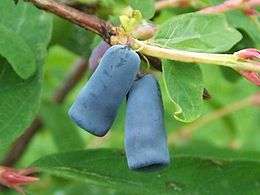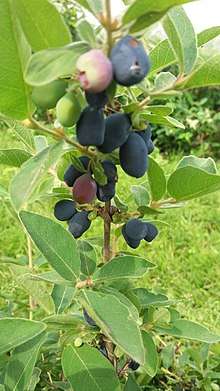Lonicera caerulea
Lonicera caerulea, also known by its common names blue honeysuckle,[2] sweetberry honeysuckle,[3] fly honeysuckle[3] (blue fly honeysuckle[4]), blue-berried honeysuckle,[5][2] or the honeyberry,[3][2] is a non-climbing honeysuckle native throughout the cool temperate Northern Hemisphere in countries such as Canada, Japan, Russia, and Poland.
| Lonicera caerulea | |
|---|---|
 | |
| Scientific classification | |
| Kingdom: | Plantae |
| Clade: | Tracheophytes |
| Clade: | Angiosperms |
| Clade: | Eudicots |
| Clade: | Asterids |
| Order: | Dipsacales |
| Family: | Caprifoliaceae |
| Genus: | Lonicera |
| Species: | L. caerulea |
| Binomial name | |
| Lonicera caerulea | |
| Synonyms[1] | |
| |
The plant or its fruit has also come to be called haskap, derived from its name in the language of the native Ainu people of Hokkaido, Japan.[2]
Haskap is a deciduous shrub growing to 1.5–2 m (4 ft 11 in–6 ft 7 in) tall. The leaves are opposite, oval, 3–8 cm (1.2–3.1 in) long and 1–3 cm (0.39–1.18 in) broad, greyish green, with a slightly waxy texture. The flowers are yellowish-white, 12–16 mm long, with five equal lobes; they are produced in pairs on the shoots. The fruit is an edible, blue berry, somewhat rectangular in shape weighing 1.3 to 2.2 grams (0.046 to 0.078 oz), and about 1 cm (0.39 in) in diameter.[6]
Classification
The classification within the species is not settled. One classification uses nine botanical varieties:[7]
- Lonicera caerulea var. altaica. Northern Asia.
- Lonicera caerulea var. caerulea. Europe.
- Lonicera caerulea var. cauriana. Western North America.
- Lonicera caerulea var. dependens. Central Asia.
- Lonicera caerulea var. edulis, synonym: L. edulis. Eastern Asia.
- Lonicera caerulea var. emphyllocalyx (also known as haskap). Eastern Asia.
- Lonicera caerulea var. kamtschatica. Northeastern Asia.
- Lonicera caerulea var. pallasii. Northern Asia, northeastern Europe.
- Lonicera caerulea var. villosa. Eastern North America.
Cultivated varieties
Improved cultivars include:
- 'Aurora'
- 'Boreal Beauty'
- 'Boreal Beast'
- 'Boreal Blizzard'
- 'Honeybee'
- 'Wojtek'
- 'Berry Blue'
- 'Indigo Gem'
- 'Indigo Treat'
- 'Indigo Yum'
- 'Tundra'
- 'Borealis'
- 'Atlaj'
- 'Nimfa'
- 'Polar Jewel'
According to research at the University of Saskatchewan, each variety can be distinguished by the size of berries, taste, and bush dimensions.[6]
Common names
Lonicera caerulea is known by several common names:[8]
- Haskap: name of the Ainu language in northern Japan[2]
- Blue honeysuckle: descriptive translation from Russian origin
- Honeyberry: common in North America
- Swamp fly honeysuckle: coined by botanists who found it growing wild in swampy areas of Canada
Distribution and habitat
The species is circumpolar, primarily found in or near wetlands of boreal forests in heavy peat soils.[9] However, it also can be found in high-calcium soils, in mountains, and along the coasts of northeastern Asia and northwestern North America. The plant is winter-hardy and can tolerate temperatures below −47 °C (−53 °F).[8]
Cultivation

Haskap variety edulis has been used frequently in breeding efforts, but other varieties have been bred with it to increase productivity and flavor. In several haskap breeding programs, the variety emphyllocalyx has been the dominant one used.[8]
Plants of many haskap cultivars grow to be 1.5 to 2 metres (4 ft 11 in to 6 ft 7 in) tall and wide, can survive a large range of soil acidity, from 3.9-7.7 (optimum 5.5-6.5), requiring high organic matter, well drained soils, and plentiful sunlight for optimum productivity. Lonicera caerulea plants are more tolerant of wet conditions than most fruit species.[8][10]
Each berry has approximately 20 seeds that resemble tomato seeds based on their size and shape, but the seeds are not noticeable during chewing.[11]
Disease
Powdery mildew is one disease documented to affect Lonicera caerulea, usually after fruit maturity in mid– to late summer.[8] When the plant is affected, it is common for the leaves to turn white, with brown patches eventually developing.[8]
Harvest and uses
Honeysuckle is harvested in late spring or early summer two weeks before strawberries for Russian type varieties, with Japanese types ripening at a similar time to strawberries.[8] The berries are ready to harvest when the inner layer is dark purple or blue. The outer layer is dark blue and looks ripened, but the inner layer may be green with a sour flavor.[8][9] Two compatible varieties are needed for cross pollination and fruit set. In North America, most Russian varieties are adapted to hardiness zones 1 to 4. The plants may take three or four years to produce an abundant harvest.[8] Average production on a good bush is about 3 kilograms (6.6 lb) and can maintain productivity for 30 years.[8]
Honeysuckle can be used in various processed products, such as pastries, jams, juice, ice cream, yogurt, sauces, candies and a wine similar in color and flavor to red grape or cherry wine.[8][9][12]
Phytochemicals
As a blue pigmented fruit, Lonicera caerulea contains polyphenol compounds, including cyanidin 3-glucoside, cyanidin 3-rutinoside, and peonidin 3-glucoside.[13][14][15] Other phytochemicals present are proanthocyanidins and organic acids, including a high content of citric acid.[16]
Traditional medicine
Over centuries in East Asian countries, Lonicera caerulea has been used for supposed therapeutic applications in traditional medicine.[17]
References
- The Plant List: A Working List of All Plant Species; Family Caprifoliaceae, Genus Lonicera by Species, The Plant List, Version 1, Royal Botanic Garden-Kew and Missouri Botanical Garden, 2010, retrieved 18 May 2016
- Small, Ernest, ed. (2013). North American Cornucopia: Top 100 Indigenous Food Plants. CRC Press. p. 135. ISBN 978-14-66585-94-2.
- "Lonicera caerulea". Natural Resources Conservation Service PLANTS Database. USDA. Retrieved 6 January 2016.
- Lahring, Heinjo, ed. (2003). Water and Wetland Plants of the Prairie Provinces. University of Regina. Canadian Plains Research Center. University of Regina Press. p. 168. ISBN 978-08-89771-62-8.
- "BSBI List 2007". Botanical Society of Britain and Ireland. Archived from the original (xls) on 2015-01-25. Retrieved 2014-10-17.
- University of Saskatchewan (2007). "Haskap: University of Saskatchewan Fruit Program". Retrieved 25 November 2016.
- USDA GRIN Taxonomy, retrieved 18 May 2016
- Bob Bors. "Growing Haskap in Canada" (PDF). University of Saskatchewan, Department of Plant Sciences.
- "Honeyberry". London, UK: The Royal Horticultural Society. 2016.
- Janick, J.; Paull, R.E. (2008). The Encyclopedia of Fruit & Nuts. CABI. p. 232. ISBN 9780851996387.
- Utioh, A., Nivet, M., Gopal, R., Alejo, D., Ghosh, P., Appah, P. (2011). "Fractionation and processing of small fruits for applications in functional foods and nutraceuticals Program" (PDF). Retrieved 28 November 2016.CS1 maint: multiple names: authors list (link)
- Reimer, Peter (2007). "Haskap wines at the University of Saskatchewan fruit program" (PDF). Retrieved 9 August 2016.
- Celli, G. B.; Khattab, R; Ghanem, A; Brooks, M. S. (2016). "Refractance Window™ drying of haskap berry--preliminary results on anthocyanin retention and physicochemical properties". Food Chemistry. 194: 218–21. doi:10.1016/j.foodchem.2015.08.012. PMID 26471547.
- Zenovia O, Lacramioara O, Elena T, Maria-Magdalena Z (2013). "Variability of anthocyanin content and dry matter amount in fruits of some lonicera caerulea selections depending on storage conditions". Analele Ştiinţifice Ale Universităţii Alexandru Ioan Cuza Din Iași, Sectiunea II A : Genetica Si Biologie Moleculara. 14 (4): 7–12.
- Caprioli, G; Iannarelli, R; Innocenti, M; Bellumori, M; Fiorini, D; Sagratini, G; Vittori, S; Buccioni, M; Santinelli, C; Bramucci, M; Quassinti, L; Lupidi, G; Vitali, L.A.; Petrelli, D; Beghelli, D; Cavallucci, C; Bistoni, O; Trivisonno, A; Maggi, F (2016). "Blue honeysuckle fruit (Lonicera caerulea L.) from eastern Russia: Phenolic composition, nutritional value and biological activities of its polar extracts". Food Funct. 7 (4): 1892–903. doi:10.1039/c6fo00203j. PMID 27040352.
- Rupasinghe, H. P.; Boehm, M. M.; Sekhon-Loodu, S; Parmar, I; Bors, B; Jamieson, A. R. (2015). "Anti-Inflammatory Activity of Haskap Cultivars is Polyphenols-Dependent". Biomolecules. 5 (2): 1079–98. doi:10.3390/biom5021079. PMC 4496711. PMID 26043379.
- Kaczmarska E, Gawronski J, Dyduch-Sieminska M, Najda A, Marecki W, Zebrowska J (2015). "Genetic diversity and chemical characterization of selected Polish and Russian cultivars and clones of blue honeysuckle (Lonicera caerulea)" (PDF). Turkish Journal of Agriculture and Forestry. 39: 394–402. doi:10.3906/tar-1404-149.
External links
| Wikimedia Commons has media related to Lonicera caerulea. |